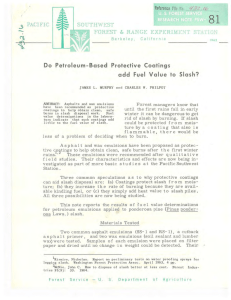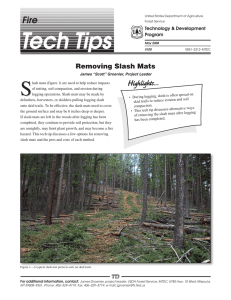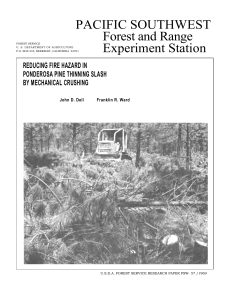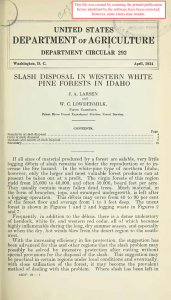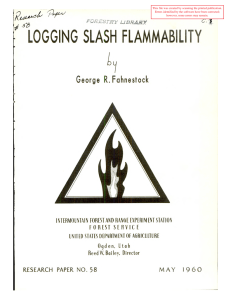58 " e me
advertisement
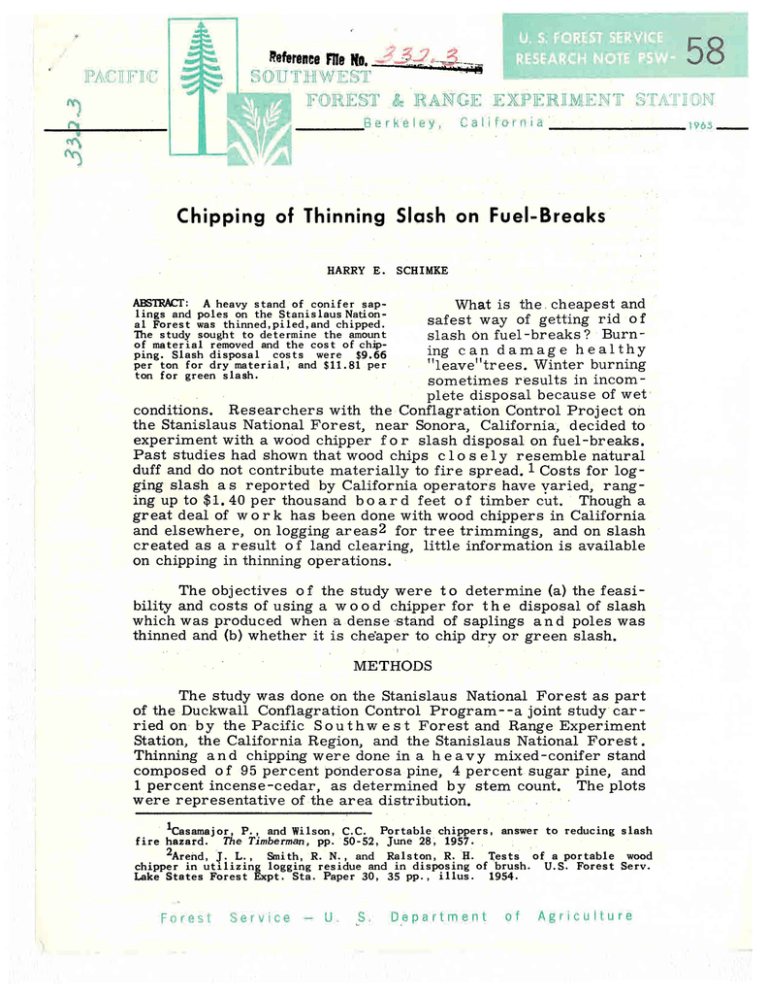
58 me Nt. ,/3.2 -"$.[T ']j' J1-]1 ""A/EST'- ..=...· ·w,;·. .;;!niii@ nI[j)~eference -...:;c..... ' .,.....;.;: . IF' ((» RE §1r _ _ _ _8 e r "ele y , C a Ii f () t 11 j a _________ 1965 _ Chipping of Thinning Slash on Fuel-Breaks HARRY E. SCHIMKE What is the, cheapest and safest way of getting rid 0 f slash on fuel-breaks? Burning can dam age h e a 1 thy "leave"trees. Winter burning sometimes results in incomplete disposal because of wet ' conditions. Researchers with the Conflagration Control Project on the Stanislaus National Forest, near Sonora, California', decided to ' experiment with a wood chipper for slash disposal on fuel-breaks. Past studies had shown that wood chips c los ely resemble natural duff and do not contribute materially to fire spread. 1 Costs for logging slaSh a s reported by California operators have yaried, ranging up to $1. 40 per thousand bo ar d feet of timber cut. ' Though a great deal of w 0 r k has been done with wood chippers in California and elsewhere, on logging areas 2 for tree trimmings, and on slash created as a result 0 f land clearing, little information is available on chipping in thinning operations. ABSTRACT: A heavy stand of conifer saplings and poles on the Stanislaus National Forest was thinned,piled,and chipped. The study sought to determine the amount of rna terial removed and the cos t of chipping. Slash disposal costs were $9.66 per ton for dry material, and $11.81 per ton for green slash. The objectives of the study were to determine (a) the feasibility and costs of using a woo d chipper for the disposal of slash which was produced when a dense 'stand of saplings and poles was thinned and (b) whether it is che'aper to chip dry or green slash. METHODS The study was done on the Stanislaus National Forest as part of the Duckwall Conflagration Control Program - -a joint study carried on by the Pacific Sou t h w est Forest and Range Experiment Station, the California Region, and the Stanislaus National Forest. Thinning and chipping were done in a he a v y mixed -conifer stand composed 0 f 95 percent ponderosa pine, 4 percent sugar pine, and 1 percent incense-cedar, as determined by stem count. The plots were representative of the area distribution. lCasamajor, P., and Wilson, C.C. Portable chippers, answer to reducing slash fire hazard. The Timberman, pp. ' 50-52, June 28, 1957. 2Arend, J. L., Smith, R. N., and Ralston, R. H. 1;'ests of a portable wood chipper in utilizing logging residue and in disposing of brush. U.S . Forest Servo Lake States Forest Expt. Stan Paper 30 , 35 pp., illus. 1954. F () r e ::. t S e r vic e - U. S. D,9 par t men t 0 fAg ri c U I t u r e A primary obj ective when constructing fuel- breaks in timber stands is to reduce the volume of flammable fuels on and near the ground, but still retain an overstory for shade. In young stands this usually means heavy thinning of the stand and pruning of the lower limbs on remaining trees. On test plots, the original stand of 3, 500 trees per acre was thinned to the best 320 trees. The trees cut averaged 2 1/2 inches in diameter. Tree length averaged 15 feet. Tables 1 to 3 present additional information on the nature of cut material which affected the thinning, piling, and chipping jobs. Table 1 presents the averaged weight of cut trees by diameter and crown class obtained by weighing a number of trees in each diameter group. Table 2 presents the number of cut stems on each plot by diameter groups. Table 3 lists the green weight of the chipped material on each plot, obtained by multiplying the average stem weight (table 1) by the number of stems (table 2). The trees on two of the four 1-square-chain plots were thinned in July, and the material left to dry during the summer. In September the slash was carried and piled at the roadside for chipping. The trees on the other twO plots were thinned in September; slash was carried to roadside, and chipped green. Only those trees too heavy to handle as a whole were sectioned. All material was stacked with the larger ends facing the road, Thechipper 3 used in this study could chip the material as fast as the men could feed it. Only the larger trees (4 -5 inches in diameter' 20-35 feet long) had to be fed into it more slowly. Toguard against flying chips, operating personnel wore protective shields. RESULTS AND CONCLUSIONS To meet fuel-break standards, we removed 91 percent of the original stems per acre, or about 3.26 tons. Slash disposal by chipping compared favorably with slash disposal by burning both in feasibility and in costs. Total costs amounted to $9. 66 per ton for dry material and $11. 81 for green (table 4). It cost $9.20 per ton to hand thin, prune, pile, and swamper - burn slash from the same stand. Where ready access made chippers practical, it was cheaper to chip dry rather than green slash because the material was lighter and easier to handle. Advantages of chipping thinning slash include these: Most stems did not have to be cut into short lengths. Immediate disposal was Juall Model KS292 , equipped with 16-inch blades, and powered by a Ford V-~ engine mounted on a truck. (Mention of commercial products does not constitute an endorsement by the u.s. Forest Service , ) -2- Table 1. Avera~e green weight of cut trees, by diameter and crown class Stump diameter (inches) Crown length, percent of height 1 2 10 40 64 102 Number of cut stems on each l-square-chain plot, by diameter ~roups I Plot 1 inch 1 2 3 4 271 388 1,114 134 215 284 381 71 Total 1,907 951 Table 3. I 5 20 30 45 75 2 3 4 5 Table 2. Weight pounds 2 inches I 4 inches I 5 inches 60 ' 124 66 46 1 3 5 7 0 6 0 1 296 16 7 I 3 inches Green weight of material cut, removed, and chipped from l-square-chain plots I Percent of total Plot Pounds 1 2 3 4 5,156 9,380 8,998 3,368 2.58 4 . 69 4.50 1.68 19 . 2 34.9 33.4 12 . 5 Total 26,902 13.45 100 . 0 Table 4. Item Thinnilfgl ChiPPlng 3 Pilin~ ,2 Cost $4.38 2.38 9.70 Ton I Costs and production in I I chippin~ Production (ton/ hour) Dry I Green 1.1 0.47 3.5 0.65 4.8 Total l I study Cost/ ton Dry 1 Green $3.98 3 . 66 2.02 $~:B~ $9.66 $11.81 2. 77 lCosts are based on California Region rates (1964) of $2.38 per hour for a permanent Forest Service laborer (laborer II), and $2 . 00 per hour for chain saw rental, which includes maintenance and operation by experienced personnel. 2Slash was carried an average distance of one-half chain. 3Costs are based on California Region rates (1964) of $2.38 per hour for laborer II, $2 . 50 per hour for a permanent GS-5 foreman, and $2.50 per hour for chipper rental, which includes maintenance, operation, and depreciation . -3 - possible, and this eliminated the fire hazard and the possibility of Ips beetle infestations. Finally, no damage to the "leave" stand resulted because of burning. The Author . . . HARRY E . SCHIMKE is a forestry research technician assigned to studies of conflagration control techniques. -4- ( ' U. S . DEPARTMENT OF AGRICULTURE POSTAGE AND FEES PAID U. S. DEPARTMENT OF AGRICULTURE FOREST SERVICE PACIFIC SOUTHWEST FOREST AND RANGE EXPERIMENT STATION POST OFFICE BOX 245 BERKELEY . CALIFORNIA 9470' OFFICIAL BUSINESS RO CKY MT FOR EXP S TA AR I Z~NA STATE COll CAM PU S FLAG ~ T AFF AR IZ ONA 86003 5 01
